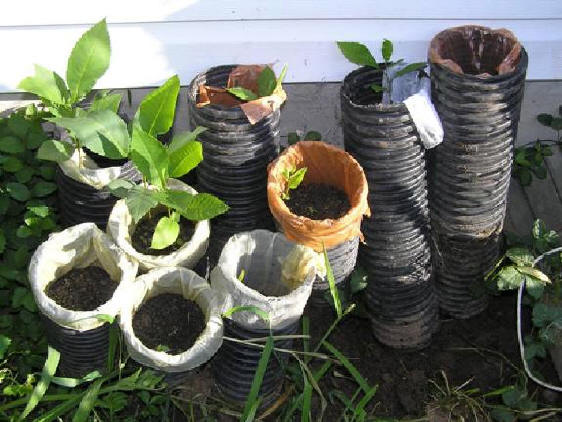|
Stratification of Seeds - Take 3
Bill Devlin
Adams County Master Gardener
"Those who teach or lead, must never cease to learn". Thus said a learned philosopher who's name escapes me. It is with that philosophy that I recycle the topic of Stratification of seeds, particularly nut seeds, adding that which I have learned the last 4 years since the last version of
this article
 First lets review the first article on the basics of stratification. First lets review the first article on the basics of stratification.
‘Fall is here or coming very soon. It's time to think about, or better yet, to act on renewing our environment. The best part of Pennsylvania is that it's truly Penn's Woods. Three hundred years ago it was nearly all woods, now there are fewer and fewer trees, as agriculture and urban development
are the order of the day. We can mitigate that situation by planting trees. Planting trees can be expensive - it doesn't have to be; it can be nearly free through the miracle of stratification. Well, maybe miracle is a little much, but the first time you try it and it works, it feels like a miracle.
What is stratification? Stratification is artificially overcoming a seed's dormancy by placing it in layers of moisture-retaining media (paper towel, potting soil, etc.) and keeping it under generally cool and moist conditions for a period of time. This will simulate winter conditions, according to
the Garden Web Glossary of Botanical Terms (http://www.gardenweb.com).
Now that we know what stratification is, let's get down to cases. Our forefathers created magnificent parks by planting or saving slow growing, huge trees like Oaks, Hickories, and Walnuts. We should be doing the same for our grandchildren and our grandchildren's grandchildren. That is how long a
white oak can take to reach maturity.
So, the recipe is to get out into the woods on these magnificent fall days and look for the kind of trees we would like our progeny to have. Collect some large acorns, walnuts, hickory nuts, or whatever, and bag them. Particularly the walnuts, they can be very messy.
When you get home, seal them in a plastic bag with a moistened piece of paper towel, and put them in the refrigerator. Real gardeners have a second refrigerator in the basement or garage. If you don't, ask around, I will venture lots of your neighbors do.
If you don't have any luck with locating a refrigerator, another method is burying them temporarily in an area where you can control access from the varmints. Dig a hole about a spade depth deep and partially fill it with clean leaves, sawdust, shredded newsprint, or similar moisture-retaining
material. Cover with a layer of hardware cloth to prevent varmits from digging the nuts up. Mark the spot so that you can dig them up and replant in the spring.
When spring rolls around, you should have planned where you want these magnificent trees to be. Prepare the ground and mulch an area a couple of feet in diameter-well marked so the seedlings won't be accidentally be mown down.
Why not just stick them in the ground? Several reasons: squirrels, mice, voles, and moles to name a few. My success with this method has been a big, fat zero. My success with the recommended method above has been over 90%.
If you don't have a place in mind to plant the trees right away, you can still get the ball rolling for later transplantation. If you don't have space for these large trees but like to dabble in horticulture, work with your local parks authority, which may be looking for donated trees.
Large seeded trees are generally taproot varieties, thus transplanting can be very problematic unless you have a scheme. My scheme is to start the stratified nuts in tubes that allow for a two-foot root to develop without danger of damaging the root, and thus killing the tree, at transplant time.
I cut about a 2' (Update: 18" length) length of 6" flexible corrugated plastic drainpipe, line it with a plastic bag, Walmart etc. or kitchen waste basket, fill it with some potting media - either commercial or topsoil mixed with mulch, etc., and stand in a shorter container that can be kept moist.
More topsoil in the bottom half will retard shrinkage with resulting corkscrewing of the tap root."

In our rabbit and deer rich environment a necessary step to growing trees from nuts and acorns is use of tree shelters. Its not a luxury, it’s a necessity. The little varmints are hungry. They eat. They love tender seedlings.
What to do? You have probably taken a ride in the lovely countryside that makes south central Pennsylvania such a wonderful place to live. You may recall seeing fields with long thin plastic tubes spaced evenly in rows. These are "Tree Shelters", a reasonably recent development in the horticulture
of trees. They perform several helpful functions. First, they provide protection from varmints, hungry rabbits and deer. Secondly, they provide a mini-greenhouse environment, keeping the wind chill down and the temperature a little higher than ambient. Third, they are a visual indicator that tree seedlings are present so
they aren't inadvertently mowed over or grazed by cattle or horses.
How to get tree shelters? Calls to local Agriculture suppliers were not fruitful (pardon the pun). An internet search was, and cost per tree shelter was reasonable but freight ran it up considerably. I would like to aide the cause of reforestation along by the following:
I placed an order for 50 tree tubes, 36" height. By shipping that many the cost per tube is reduced considerably, so I will offer on a first com, first serve basis at $2.50 each, maximum 5 per person, f.o.b. my house, 10 Black Bass Trail, Carroll Valley. Use map quest to get a route there. If you
are not in the area, you will probably do better ordering over the internet, search ‘tree shelters". The minimum shipping is $10.50 for 4 pounds, so you can figure the mileage that defines ‘in the area’.
This fall, I will collect and start stratification of several dozen acorns, pecans, and walnuts. If you stay in contact by email (devlinw1@aol.com) I can provide you some of these. One of my pet peeves is people who change email addresses every few months and mess up my address book particularly the
groups. My address has been the same since 1989.
Over the next couple of months I am delivering several started Pecans and Walnuts. The Walnuts seem to start much faster than the pecans, several times I have despaired over the failure of my pecans to come up, only to see them show a week or two later.
Here’s two pictures of my two most recent successes. (I don’t document my failures). Walnuts are in the 3 tube picture, pecans in the multiple tube picture.
Read other articles on gardening techniques
Read other articles By Bill Devlin |